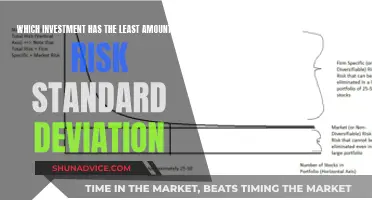
Investing is a great way to make your money work for you. There are many ways to invest, from low-risk options such as CDs and money market accounts to medium-risk options like corporate bonds, and even higher-risk picks like stock index funds.
When deciding what to invest in, it's important to consider your risk tolerance, time horizon, knowledge of investing, financial situation, and how much you can invest.
1. Stocks: A stock is a share of ownership in a company. Stocks are also known as equities and can be purchased individually or through mutual funds or exchange-traded funds (ETFs).
2. Bonds: A bond is a loan to a company or government entity, which agrees to pay you back with interest over a fixed period.
3. Mutual Funds: A mutual fund is a collection of stocks, bonds, or other investments packaged together, allowing investors to diversify their portfolio without having to pick individual stocks.
4. Exchange-Traded Funds (ETFs): Similar to mutual funds, but ETFs trade on major stock exchanges and can be bought and sold throughout the trading day.
5. Real Estate: You can invest in real estate directly by purchasing property or indirectly through real estate investment trusts (REITs), which trade on stock exchanges and offer diversification and regular dividends.
6. High-Yield Savings Accounts: Some online banks offer competitive interest rates on savings accounts, providing a low-risk option for short-term savings.
7. Certificates of Deposit (CDs): CDs offer guaranteed yields for a fixed period, making them a good option when interest rates are high.
8. Cryptocurrencies: Cryptocurrencies like Bitcoin and Ethereum are a relatively new form of investment that can be incorporated into a diversified portfolio.
Remember, investing carries risk, and it's important to do your research and understand your financial goals before making any investment decisions.
| Characteristics | Values |
|---|---|
| Risk tolerance | Low, Medium, High |
| Investment types | High-yield savings accounts, CDs, Bonds, Money market funds, Mutual funds, Index funds, ETFs, Dividend stocks, REITs, Bitcoin ETFs, S&P 500 index funds, Nasdaq-100 index funds, Stocks, Corporate bonds, Treasury notes, etc. |
| Investment goals | Retirement, College, Financial freedom, etc. |
| Time horizon | Short-term, Medium-term, Long-term |
| Investment accounts | 401(k), IRA, SEP IRA, Solo 401(k), Roth IRA, Taxable brokerage, Coverdell Education Savings Account, 529 College Savings, etc. |
| Investment strategy | Active investing, Passive investing, Dollar cost averaging, etc. |
What You'll Learn

High-yield savings accounts
- No Minimum Balance or Monthly Fees: Many high-yield savings accounts have no minimum balance requirements and no monthly maintenance fees, making them accessible to a wide range of individuals.
- FDIC Insurance: High-yield savings accounts offered by banks are federally insured up to $250,000 per depositor, providing a level of security for your funds.
- Online Accessibility: High-yield savings accounts are often provided by online banks, which means you can access and manage your account from anywhere through a mobile app or website.
- Competitive Interest Rates: By choosing an online bank, you can take advantage of competitive interest rates that are typically higher than those offered by traditional brick-and-mortar banks.
- Easy Transfers: High-yield savings accounts usually allow you to transfer funds easily between your savings and checking accounts, providing flexibility and convenience.
When considering a high-yield savings account, it's important to compare the interest rates and features offered by different financial institutions. Additionally, while high-yield savings accounts provide a safe and secure way to grow your savings, they may not offer the same level of returns as riskier investments. It's always a good idea to diversify your investment portfolio and seek advice from a financial professional to make informed decisions.
Are 5% Monthly Investment Portfolio Gains Achievable?
You may want to see also

Short-term investments, e.g. certificates of deposit (CDs)
Short-term certificates of deposit (CDs) are a great investment option for those looking for a secure, flexible way to grow their money. CDs are time deposit accounts that offer a fixed interest rate over a set period, known as the maturity term or CD term. Short-term CDs typically have maturities of less than a year, while long-term CDs have maturities of one year or more.
When you open a CD, you agree to leave your money in the account until the maturity date. This means that short-term CDs give you access to your funds much faster. Short-term CDs are ideal for investors who want to keep their money secure for a brief period while earning higher interest than they would with a standard savings account. They are well-suited for those saving for short-term goals, like a vacation or new furniture, or those who expect CD rates to rise soon.
The flexibility of short-term CDs means you can take advantage of rising interest rates sooner, as you can reinvest your funds at the end of the term. However, the trade-off is that short-term CD rates are typically lower than long-term CD rates. Banks often reward savers who choose long-term CDs with higher rates.
When choosing a CD, it's important to consider the maturity term and how well that matches your financial goals. It's also good to shop around to find the best CD rates for the maturity term you're seeking. Doing your research beforehand can help you find the right CD option.
CDs are federally insured, so you don't have to worry about losing your money. In the US, CDs are insured for up to $250,000 per depositor, per account ownership type, per financial institution. This insurance is provided by the Federal Deposit Insurance Corporation (FDIC) for banks and the National Credit Union Administration (NCUA) for credit unions.
Understanding Private Equity Investment Trusts and Their Benefits
You may want to see also

Medium-term investments, e.g. corporate bond funds
Medium-term investments, such as corporate bond funds, can be an excellent addition to your portfolio. These funds comprise bonds issued by corporations with an average maturity of three to eight years. They are a good choice for investors seeking cash flow, such as retirees, or those wanting to reduce their portfolio risk while maintaining a decent return.
Corporate bond funds can be a good option for risk-averse investors who want a higher yield than government bond funds. They are not FDIC-insured, so there is a chance of companies defaulting on the bonds. To mitigate this risk, ensure your fund consists of high-quality corporate bonds from a diverse range of companies.
Compared to government and municipal bond funds, investment-grade medium-term corporate bond funds often reward investors with higher returns. However, this greater reward comes with a slightly higher risk.
You can buy and sell these funds through brokers that allow you to trade ETFs or mutual funds. Most brokers allow you to trade ETFs without a commission, while mutual funds may require a minimum purchase or a broker's commission.
When considering medium-term corporate bond funds, it is essential to evaluate your financial goals, risk tolerance, and investment timeline. These funds are suitable for those seeking cash flow or reduced portfolio risk and are willing to accept a moderate level of risk for potentially higher returns.
Why Law Firms Need Managed IT Services
You may want to see also

Long-term investments, e.g. dividend stock funds
Dividend stock funds are a great long-term investment option for those seeking a fixed income and stability. Dividend stocks are companies that regularly distribute a portion of their earnings to investors in the form of additional shares or cash. Dividend yield is calculated by dividing the annual per-share dividend payment by the share price.
Some popular dividend stocks include AT&T, Walgreens Boots Alliance, and 3M, which offer dividend yields of more than 5%. Dividend stocks can be an attractive option for older investors as they provide a regular cash payout, and the best stocks can raise their payouts over time.
Dividend-paying companies are typically more mature and established, and therefore generally considered safer. However, if a dividend-paying company doesn't earn enough to pay its dividend, it will cut the payout, and its stock may plummet.
If you're looking for a diversified set of stocks, you can opt for a dividend stock fund. These funds are available at any online broker that offers stock trading.
Vacating Investment Portfolios: When and Why You Should Exit
You may want to see also

Risk-averse investments, e.g. short-term treasury ETFs
Short-term Treasury ETFs are a good investment option for those who are risk-averse. They are ideal for investors who need ready access to their cash, as they can be sold any day the market is open. These funds are also a good safe haven for investors, as their holdings are backed by the US government.
Treasury ETFs are traded on stock exchanges, like individual stocks, and they hold a portfolio of US Treasury securities. Each ETF differs in time to maturity, from less than a year up to 30 years. They are designed to track the performance of Treasurys, including short-, intermediate-, and long-term maturities of Treasury bills, notes, and bonds.
Treasury ETFs are highly liquid, meaning you can buy and sell shares throughout the trading day at market prices. They are also highly accessible, as they can be bought and sold like stocks through a brokerage account, with no minimum investment.
There are a few risks to consider with Treasury ETFs. They are subject to interest rate risk, meaning that when interest rates increase, the price of existing bonds typically decreases, and vice versa. They also carry the risk of market volatility, as prices can fluctuate based on market sentiment, economic data, and geopolitical events.
- SPDR Bloomberg 1-3 Month T-Bill ETF
- JPMorgan Ultra-Short Income ETF
- PIMCO Enhanced Short Maturity Active Exchange-Traded Fund ETF
- Vanguard Short-Term Inflation-Protected Securities Index Fund ETF Shares
Valuing Investment Management Firms: Strategies for Success
You may want to see also
Frequently asked questions
Some good investment options for beginners include exchange-traded funds (ETFs), mutual funds, and index funds. These options provide diversification and are generally less risky than investing in individual stocks. You can also consider using a robo-advisor, which uses algorithms to make investment recommendations based on your risk profile.
You can start investing with a small amount of money. Many investment options, such as index funds, ETFs, and mutual funds, have low or no minimum investment requirements. You can also take advantage of fractional share investing, which allows you to purchase partial shares of stocks.
There are several factors to consider when deciding what to invest in. Firstly, evaluate your financial situation, investment goals, and time horizon. Secondly, consider your risk tolerance and how much risk you are comfortable taking. Diversification is also important to reduce risk. Additionally, it's essential to understand the different types of investments available, such as stocks, bonds, mutual funds, and real estate, and the risks and potential returns associated with each.







